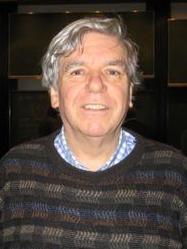Martin Huxley
Martin Neil Huxley (* 1944 in Worksop ) is a British mathematician who specializes in analytical number theory.
Huxley received his PhD in 1970 from Harold Davenport (who died during this time in 1969) at Cambridge University (A large sieve inequality for algebraic number fields). He is Professor of Mathematics at the University of Cardiff .
In 1972 he proved a theorem about the distances between successive prime numbers, which intensified a result by Guido Hoheisel : be the nth prime number and then is
for sufficiently large n. He also made progress in estimating the distance between successive prime numbers according to Paul Erdős (see prime number twin ) and in 1977 was able to set the upper bound for:
Press 0.44 (using Erdős, Hardy / Littlewood, and Bombieri / Davenport methods).
He also made advances in Lindelöf's conjecture for the Riemann zeta function .
Fonts
- The distribution of prime numbers: large sieves and zero-density theorems, Oxford, Clarendon Press 1972
- Area, lattice points, and exponential sums, Oxford University Press 1996
- Edited with GRH Greaves, G. Harman: Sieve methods, exponential sums, and their applications in number theory: proceedings of a symposium held on Cardiff, July 1995, Cambridge University Press 1997
- Small differences between consecutive primes , Part 1,2, Mathematika, Volume 20, 1973, pp. 229-232, Volume 24, 1977, pp. 142-152
- Large gaps between prime numbers , Acta Arithmetica, Volume 38, 1980, 63-68
- Large values of Dirichlet polynomials , Part 1-3, Acta Arithmetica, Volume 24, 1973, 329-346, Volume 27, 1975, 159-169, Volume 26, 1975, 435-444
Web links
Individual evidence
- ↑ Martin Huxley in the Mathematics Genealogy Project (English)
- ↑ Huxley On the difference between consecutive primes , Inventiones Mathematicae, Volume 15, 1972, pp. 164-170
| personal data | |
|---|---|
| SURNAME | Huxley, Martin |
| ALTERNATIVE NAMES | Huxley, Martin Neil (full name) |
| BRIEF DESCRIPTION | British mathematician |
| DATE OF BIRTH | 1944 |
| PLACE OF BIRTH | Worksop |




